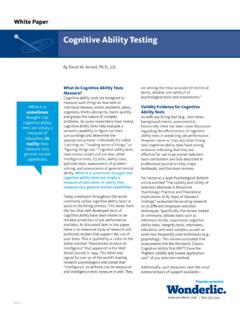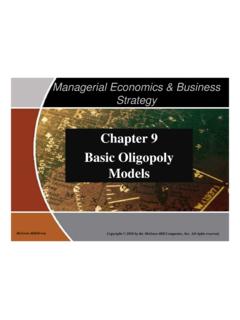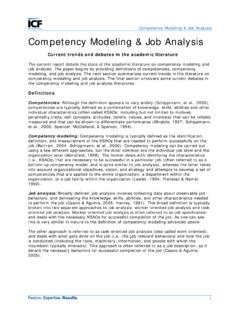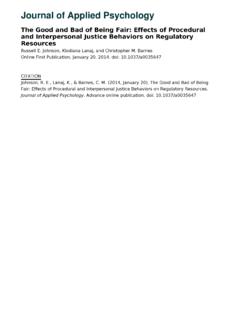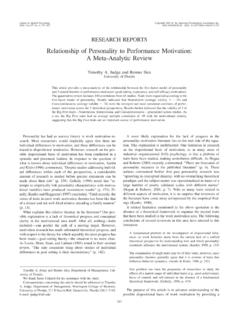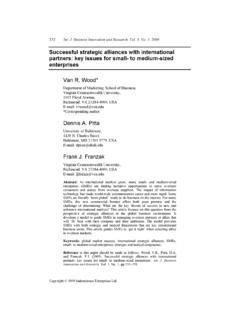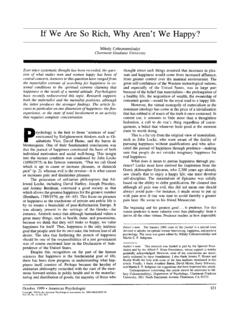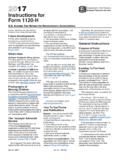Transcription of New Lectures5&6&7 PM Scheduling IP ENCE603 ext …
1 ENCE 603. Management Science Applications in project Management Lectures 5-7. project Management LP Models in Scheduling , Integer Programming Spring 2009. Instructor: Dr. Steven A. Gabriel ~sgabriel 1. Copyright 2008, Dr. Steven A. Gabriel Outline project Scheduling Critical Path Method (CPM). AON and AOA methods project Crashing Precedence Diagramming Method (PDM). Gantt Charts 2. Copyright 2008, Dr. Steven A. Gabriel 1. project Networks project activities described by a network Can use the activity-on-node (AON) model Nodes are activities, arrows (arcs) indicate the precedence relationships Could also consider the activity-on-arc (AOA) model which has arcs for activities with nodes being the starting and ending points AON used frequently in practical, non-optimization situations, AOA is used in optimization settings First AON, then AOA. Main idea for both is to determine the critical path ( , tasks whose delay will cause a delay for the whole project ).
2 3. Copyright 2008, Dr. Steven A. Gabriel project Networks Sample project network (AON) (read left to right). Dashed lines indicate dummy activities Key: Activity, Duration (days). 4. Copyright 2008, Dr. Steven A. Gabriel 2. Network Analysis Network Scheduling : Main purpose of CPM is to determine the critical path . Critical path determines the minimum completion time for a project Use forward pass and backward pass routines to analyze the project network Network Control: Monitor progress of a project on the basis of the network schedule Take correction action when required Crashing the project Penalty/reward approach 5. Copyright 2008, Dr. Steven A. Gabriel Activity on Node (AON). Representation of project Networks 6. Copyright 2008, Dr. Steven A. Gabriel 3. project Networks A: Activity identification (node). ES: Earliest starting time EC: Earliest completion time LS: Latest starting time LC: Latest completion time t: Activity duration P(A): set of predecessor nodes to node A.
3 S(A): set of successor nodes to node A. 7. Copyright 2008, Dr. Steven A. Gabriel project Networks In tabular form Sample Computations Activity Predecessor Duration A n/a 2. ES(A) =Max{EC(j), j in P(A)}=EC(start)=0. B n/a 6 EC(A)=ES(A)+tA=0+2=2. C n/a 4 ES(B)= EC(start)=0. D A 3. EC(B)=ES(B)+ tB=0+6=6. E C 5. F A 4 ES(F)= EC(A)=2. G B,D,E 2 EC(F)= ES(F)+4=6, etc. A,2 F,4. D,3. end start B,6 G,2. C,4 E,5. 8. Copyright 2008, Dr. Steven A. Gabriel 4. project Networks Notation: Above node ES(i), EC(i), below node LS(i),LC(i). Zero project slack convention in force 0,2 2,6. A,2 F,4. 2,5 7,11. 4,6 D,3 11,11. 0,0 0,6 9,11. 6,9 end start B,6 G,2. 11,11. 0,4 4,9. 0,0 3,9 9,11. C,4 E,5. Sample Computations 0,4 4,9. LC(F) =Min{LS(i), i in S(F))}=11. LS(F)=LC(F)-tF=11-4=7. etc. 9. Copyright 2008, Dr. Steven A. Gabriel project Networks During the forward pass, it is assumed that each activity will begin at its earliest starting time An activity can begin as soon as the last of its predecessors has finished C must wait for both A and B to finish before it can start A Completion of the forward pass determines the C earliest completion time of the project B.
4 During the backward pass, it is assumed that each activity begins at its latest completion time Each activity ends at the latest starting time of the first activity in the project network 10. Copyright 2008, Dr. Steven A. Gabriel 5. project Networks Note: 1=first node (activity),n=last node,i,j=arbitrary nodes, P(i)= immediate predecessors of node i, S(j)= immediate successors of node j, Tp= project deadline time 1 4. P(3)= {1,2}. 3. 2 S(3)= {4,5}. 5. Rule 1: ES(1)=0 (unless otherwise stated) i1. Rule 2: ES(i)=Max j in P(i) {EC(j)} i i2. Why do we use max of the i3. predecessor EC's in rule 2? 11. Copyright 2008, Dr. Steven A. Gabriel project Networks Rule 3: EC(i)=ES(i)+ti Rule 4: EC( project )=EC(n). Rule 5: LC( project )=EC( project ) zero project slack convention (unless otherwise stated for example, see Rule 6). Rule 6: LC( project )=Tp Rule 7: LC(j) =Min i in S(j) LS(i). Rule 8: LS(j)=LC(j)-tj j1. Why do we use min in the successor LS's in rule j j2.
5 7? j3. 12. Copyright 2008, Dr. Steven A. Gabriel 6. project Networks Total Slack: Amount of time an activity may be delayed from its earliest starting time without delaying the latest completion time of the project TS(j)=LC(j)-EC(j) or TS(j)=LS(j)-ES(j). Those activities with the minimum total slack are called the critical activities ( , kitchen cabinets ). Examples of activities that might have slack Free Slack: Amount of time an activity may be delayed from its earliest starting time without delaying the starting time of any of its immediate successors. FS(j)= Min i in S(j) {ES(i)-EC(j). Let's consider the sample network relative to critical activities and slack times 13. Copyright 2008, Dr. Steven A. Gabriel CPM-Determining the Critical Path AON. Step 1: Complete the forward pass Step 2: Identify the last node in the network as a critical activity Step 3: If activity i in P(j) and activity j is critical, check if EC(i)=ES(j).}
6 If yes activity i is critical. When all i in P(j). done, mark j as completed Step 4: Continue backtracking from each unmarked node until the start node is reached 14. Copyright 2008, Dr. Steven A. Gabriel 7. CPM-Forward Pass Example 2,6. AON. 0,2. A,2 F,4. 2,5. D,3 11,11. 0,0 0,6 9,11. end start B,6 G,2. 0,4 4,9. C,4 E,5. Notation: Above node ES(i), EC(i). Activity Predecessor Duration Sample Computations A - 2 ES(A) =Max{EC(j), j in P(A)}=EC(start)=0. B - 6 EC(A)=ES(A)+tA=0+2=2. C - 4. ES(B)= EC(start)=0. D A 3. EC(B)=ES(B)+ tB=0+6=6. E C 5. ES(F)= EC(A)=2. F A 4. EC(F)= ES(F)+4=6, etc. G B,D,E 2. 15. Copyright 2008, Dr. Steven A. Gabriel CPM-Backward Pass Example AON. Notation: Above node ES(i), EC(i), below node LS(i),LC(i). Zero project slack convention in force 0,2 2,6. A,2 F,4. 2,5 7,11. 4,6 D,3 11,11. 0,0 0,6 9,11. 6,9 end start B,6 G,2. 11,11. 0,4 4,9. 0,0 3,9 9,11. C,4 E,5 Sample Computations LC(F) =Min{LS(i), i in S(F))}=11.
7 0,4 4,9. LS(F)=LC(F)-tF=11-4=7. etc. 16. Copyright 2008, Dr. Steven A. Gabriel 8. CPM-Slacks and the Critical Path AON. Total Slack: Amount of time an activity may be delayed from its earliest starting time without delaying the latest completion time of the project TS(j)=LC(j)-EC(j) or TS(j)=LS(j)-ES(j). Those activities with the minimum total slack are called the critical activities. Examples of activities that might have slack Free Slack: Amount of time an activity may be delayed from its earliest starting time without delaying the starting time of any of its immediate successors. FS(j)= Min i in S(j) {ES(i)-EC(j)}. Other notions of slack time , see Badiru-Pulat Let's consider the sample network relative to critical activities and slack times 17. Copyright 2008, Dr. Steven A. Gabriel CPM Analysis for Sample Network AON. Activity Duration ES EC LS LC TS FS Critical (Days) Activity? A 2 0 2 4 6 6-2=4 Min{2,2}-2=0 No B 6 0 6 3 9 9-6=3 Min{9}-6=3 No C 4 0 4 0 4 4-4=0 Min{4}-4=0 YES.
8 D 3 2 5 6 9 9-5=4 Min{9}-5=4 No E 5 4 9 4 9 9-9=0 Min{9}-9=0 YES. F 4 2 6 7 11 11-6=5 Min{11}-6=5 No G 2 9 11 9 11 11-11=0 Min{11}-11=0 YES. 0,2 2,6 Total project Slack TS(1)+TS(C)+TS(E)+TS(G)+TS(n)=0. A,2 F,4. 2,5 7,11. 4,6 D,3 11,11. 0,0 0,6 9,11. 6,9 end start B,6 G,2. 0,4 4,9 11,11. 0,0 3,9 9,11. C,4 E,5. 0,4 4,9 18. Copyright 2008, Dr. Steven A. Gabriel 9. project Networks When results of a CPM analysis are matched up with a calendar, then we obtain a project schedule Gantt chart is a popular way to present this schedule Using the ES times from the sample AON project network, we have the following Gantt chart (could also use latest completion times as well, extreme case when all slack times are fully used). 19. Copyright 2008, Dr. Steven A. Gabriel project Networks G. F. E. D. C. B. A. 1 2 3 4 5 6 7 8 9 10 11 Days Note, Gantt chart shows for example: Starting time of F can be delayed until day 7 (TS=5) w/o delaying overall project Also, A, D, or both may be delayed by a combined total of four days (TS=4) w/o delaying the overall project B may be delayed up to 3 days without affecting the overall project completion time Can ignore precedence arrows (better20for large networks).
9 Copyright 2008, Dr. Steven A. Gabriel 10. Activity on Arc (AOA). Representation of project Networks 21. Copyright 2008, Dr. Steven A. Gabriel project Networks: Activity on Arc (AOA) Representation Node Node i j arc(i,j)=activity(i,j). Nodes represent the realizations of some milestones (events). of the project Arcs represent the activities Node i, the immediate predecessor node of arc(i,j) is the start node for the activity Node j, the immediate successor node of arc(i,j) is the end node for the activity Want to determine the critical path of activities, , those with the least slack 22. Copyright 2008, Dr. Steven A. Gabriel 11. Activity on Arc (AOA) Representation The early event time for node i, ET(i), is the earliest time at which the event corresponding to node i can occur The late event time for node i, LT(i), is the latest time at which the event corresponding to node i can occur w/o delaying the completion of the project Let tij be the duration of activity (i,j).
10 The total float (slack) TF(i,j) of activity (i,j) is the amount by which the starting time of (i,j) could be delayed beyond its earliest possible starting time w/o delaying the completion of the project (assuming no other activities are delayed). TF(i,j)=LT(j)-ET(i)-tij The free float of (i,j), FF(i,j) is the amount by which the starting time of activity (i,j) can be delayed w/o delaying the start of any later activity beyond its earliest possible starting time FF(i,j) = ET(j)-ET(i)-tij 23. Copyright 2008, Dr. Steven A. Gabriel AOA Network Structure The network is acyclic (o/w an activity would precede itself). 1 2 3. Each node should have at least one arc directed into the node and one arc directed out of the node (with the exception of the start and end nodes), why? Start node has does not have any arc into it and the end node has no arc out of it All of the nodes and arcs of the network have to be visited (that is realized) in order to complete the project , why?

